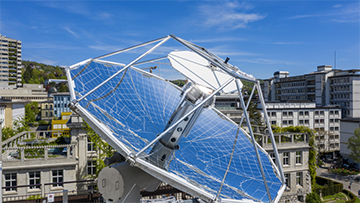
A research project in Zurich, Switzerland, uses a large parabolic solar concentrator to drive a process for converting sunlight and air into purportedly carbon-neutral jet fuel. [Image: ETH Zürich / Alessandro Della Bella]
In the wake of the COVID-19 pandemic, carbon dioxide emissions from the aviation industry fell by one-third in 2020 to their lowest point seen in 23 years. But global air passenger numbers are projected to surpass pre-pandemic levels after 2023, according to the International Energy Agency, and air cargo traffic has already exceeded what was recorded in 2019.
One promising solution to decarbonize aviation is the development of sustainable fuels. To this end, researchers in Europe have built a proof-of-concept rooftop system that can produce carbon-neutral solar aircraft fuel from sunlight and air (Nature, doi: 10.1038/s41586-021-04174-y). In addition to demonstrating the entire solar fuel production chain under real field conditions, they recommend a policy framework to bring these fuels to market and enable widespread deployment.
Mini-solar refinery
Solar fuels use the energy of sunlight to convert common substances such as carbon dioxide and water into clean alternative fuels. They have the potential to be an abundant supply of sustainable, portable and storable energy.
However, the field of solar fuel development remains in its infancy. Solar fuel production using water and carbon dioxide that has been directly extracted from air had previously been demonstrated in laboratory experiments or single-step pilot projects. For the current study, researchers at ETH Zürich in Switzerland built a mini-solar refinery on a rooftop to test the feasibility of the technology in the real world.
“Two years ago, the team at ETH finished their prototype and demonstrated that it can produce liquid fuel from sunlight and air under real environmental conditions—actually quite suboptimal conditions, since you have intermittent sun, air pollution, and so forth,” said study author Johan Lilliestam, a research group leader at the Institute for Advanced Sustainability Studies in Germany. This time, the team could take the technology one step further, he said.
A three-step process
The refinery is made up of three modules in series that each contribute to a multi-step thermochemical cycle. First, a direct air capture unit extracts carbon dioxide and water from ambient air. Next, a solar redox unit uses concentrated solar radiation to split the carbon dioxide and water into a mixture of carbon monoxide and hydrogen, known as syngas. Lastly, a gas-to-liquid unit converts syngas into liquid hydrocarbons or methanol.
Two identical solar reactors are positioned at the focus of a large solar parabolic concentrator for performing the redox steps of the thermochemical cycle. The concentrator is designed to alternate the concentrated solar input between the two reactors. A representative 7-hour day run of the system produced 96.2 L of syngas, which was then converted into 3.2 cl of pure methanol. The same solar reactor design was employed in another experiment by the researchers to synthesize solar kerosene.
Going bigger to get cheaper
Lilliestam, also a professor of energy policy at the University of Potsdam, Germany, emphasizes that substantial process optimization and upscaling will be necessary for solar aircraft fuels to enter the market. The current system uses a 5-thermal-kilowatt solar reactor with an overall system efficiency of approximately 0.8%. The next step would be to get a commercial-scale production unit on the ground, such as a tower with an array of solar reaction modules attached to solar concentrators.
"For photovoltaics, costs did not come down in the lab—they came down in the market. Costs came down by developing factories and production processes. That’s when learning and economies of scale happen," he said. "There is no reason to believe things would be any different for solar fuels."
